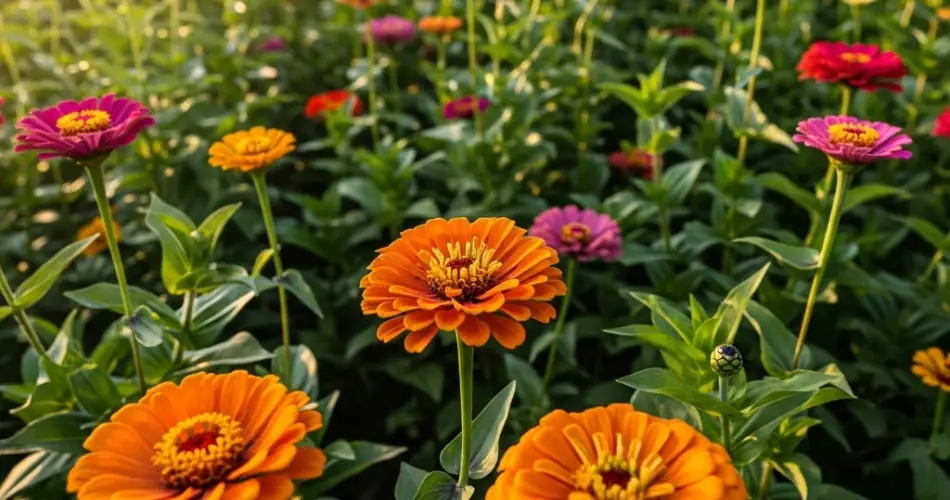Zinnias are cheerful, low-maintenance annuals that bring vibrant color and pollinator activity to any garden. But did you know these bold blooms are also excellent companion plants? Zinnias not only enhance the beauty of your garden, but they can also support the growth of vegetables, herbs, and other flowers when strategically planted. Companion planting with zinnias can help deter pests, attract beneficial insects, and create a thriving, balanced garden ecosystem.
Here’s a guide to some of the best companion planting ideas with zinnias, including what to plant with them—and what to avoid.
Why Use Zinnias for Companion Planting?
Zinnias offer several benefits in the garden beyond their ornamental appeal:
-
Attract pollinators: Their bright, open blooms draw bees, butterflies, and hummingbirds.
-
Lure beneficial insects: Ladybugs, lacewings, and parasitic wasps that feed on garden pests are often attracted to zinnias.
-
Create a trap crop: Zinnias can attract pests like aphids and spider mites, keeping them away from more vulnerable plants.
-
Improve garden aesthetics: Interplanting zinnias adds bursts of color among green vegetable rows.
With these qualities, zinnias are valuable allies for many edible and ornamental plants.
Best Companion Plants for Zinnias
1. Tomatoes
Zinnias are fantastic companions for tomatoes. They attract pollinators that improve fruit set and lure predatory insects that help control aphids and whiteflies.
Tip: Plant zinnias at the ends of tomato rows or along garden borders for easy access and airflow.
2. Cucumbers
Zinnias help attract bees and butterflies that are essential for cucumber pollination. They also draw predatory insects that control cucumber beetles.
Spacing idea: Use zinnias as a colorful border around cucumber mounds or trellises.
3. Peppers
Peppers can benefit from zinnias’ ability to attract beneficial insects like hoverflies, which feed on aphids. Zinnias also add a burst of color to pepper beds, making them more visually appealing.
4. Beans
Beans and zinnias coexist well, and zinnias won’t compete heavily for nutrients. The flowers bring in pollinators that also benefit bean blossoms.
Bonus: If you grow pole beans, zinnias planted nearby add a vertical and horizontal visual contrast.
5. Squash and Zucchini
Like cucumbers, squash and zucchini benefit from the increased pollinator activity zinnias provide. Since squash plants are prone to pests like squash bugs, the predatory insects attracted by zinnias offer extra protection.
6. Basil
Basil grows well with zinnias and enjoys similar sun and watering conditions. Both attract beneficial insects, making this a practical and attractive herb-flower duo.
7. Carrots
Carrots may not require pollinators, but planting zinnias nearby brings in insects that control carrot flies and aphids. Plus, zinnias can help mark carrot rows with colorful blooms.
8. Lettuce and Greens
Leafy greens like lettuce or spinach enjoy some afternoon shade—especially in warm climates. Tall zinnias planted nearby can provide light shade while attracting helpful insects to keep pest numbers down.
Flowers That Pair Well with Zinnias
1. Marigolds
Marigolds and zinnias together create a bright, cheerful flower bed. Both repel harmful insects and attract pollinators. Their similar growth habits make them ideal neighbors.
2. Cosmos
Cosmos and zinnias bloom throughout summer and complement each other with their open flower forms and colorful petals. They both attract bees and butterflies.
3. Salvia
Salvia and zinnias make a striking visual pair. Both are heat-tolerant and bloom profusely, making them great for borders or pollinator gardens.
4. Sunflowers
Zinnias and sunflowers thrive in the same sunny conditions. Sunflowers can provide partial shade for zinnias during the hottest part of the day, especially in scorching climates.
What Not to Plant with Zinnias
Zinnias are generally easy-going, but a few combinations are less ideal:
-
Garlic and onions: While not harmful, these don’t benefit from zinnias and may deter pollinators due to their strong scent.
-
Potatoes: Zinnias and potatoes may attract similar pests, which can lead to increased infestations in small garden spaces.
-
Very large, dense shrubs: These can shade out zinnias and compete for nutrients and water.
Tips for Successful Companion Planting with Zinnias
-
Give them space: Zinnias need good air circulation to prevent powdery mildew.
-
Keep them deadheaded: Removing spent blooms encourages new flowers and keeps pollinators coming.
-
Choose varieties by height: Dwarf zinnias work well in the front of beds, while taller types are great for back rows or borders.
-
Rotate them yearly: Avoid planting zinnias in the same spot each year to prevent disease buildup.
Final Thoughts
Zinnias are more than just pretty flowers—they’re useful allies in a thriving garden. Their ability to attract pollinators and pest predators makes them valuable companions for a wide range of vegetables, herbs, and other blooms. By thoughtfully pairing zinnias with the right plants, you can enjoy a garden that’s both beautiful and more productive. Whether you’re growing food, flowers, or a bit of both, zinnias add color, charm, and purpose to your planting plan.



